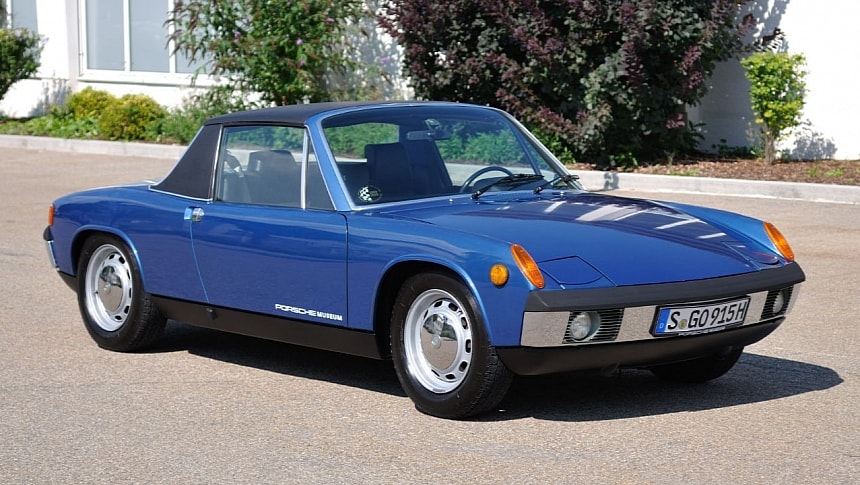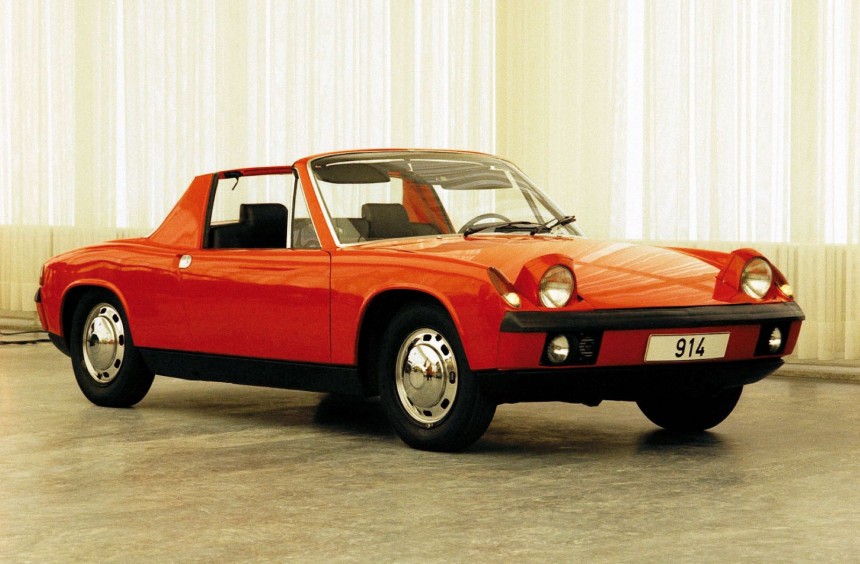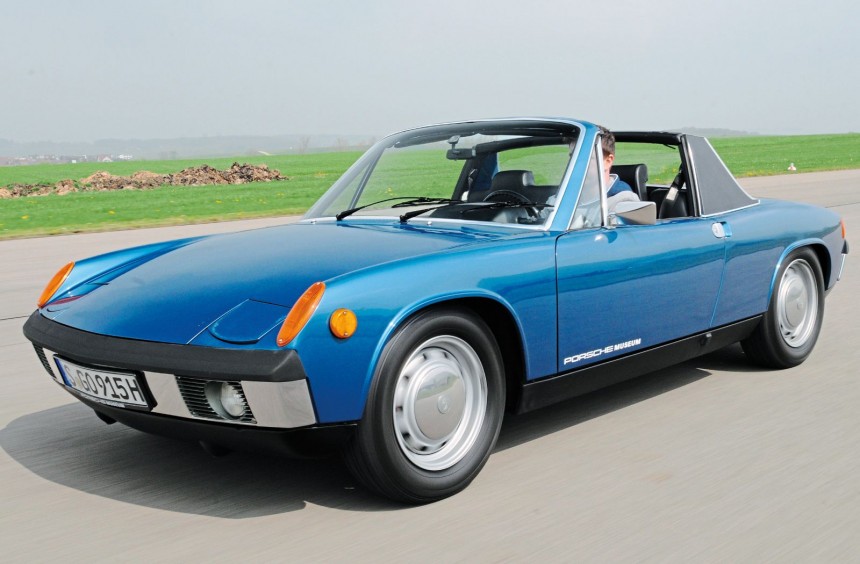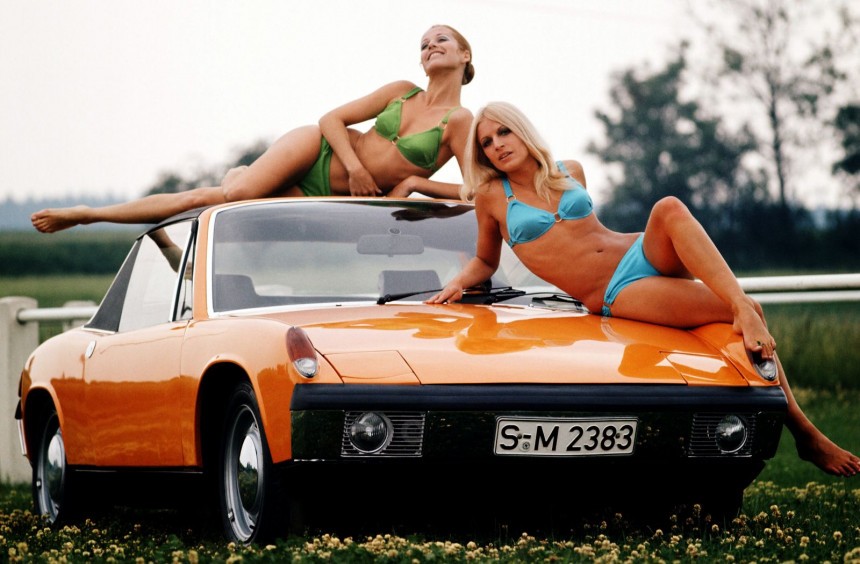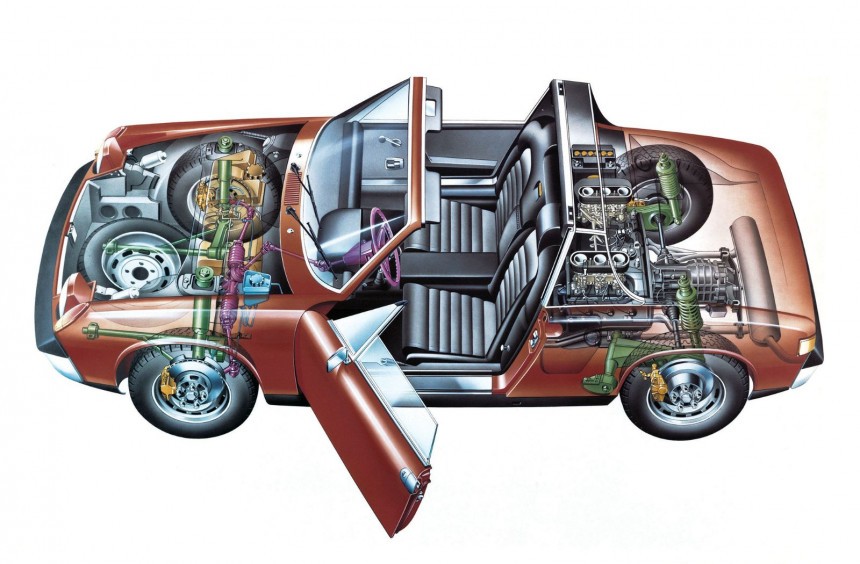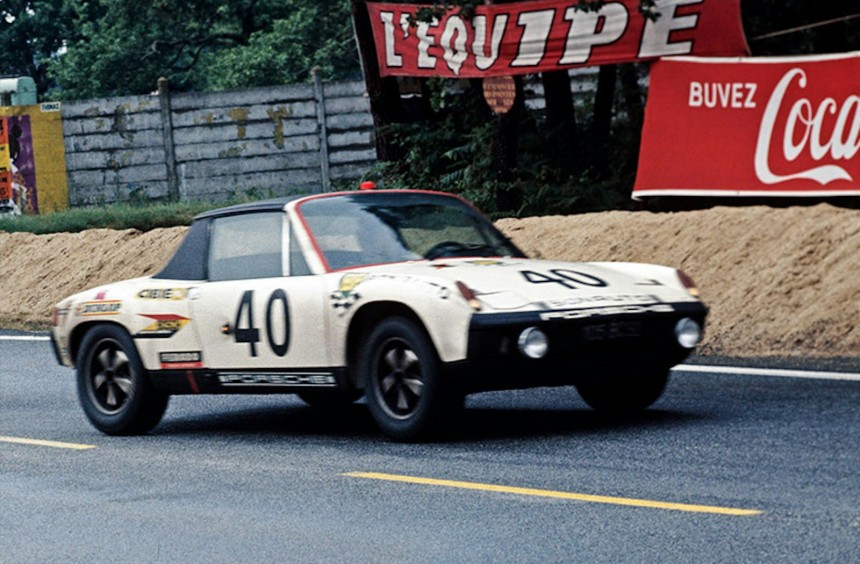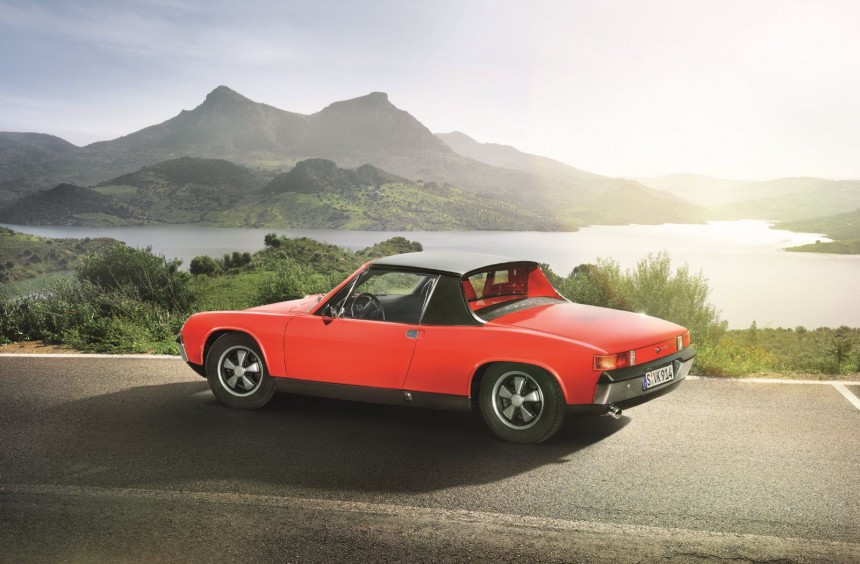Co-developed with Volkswagen, the 914 was a quirky departure from the 911, and today, many people unjustly see it as a failed experiment that lacks the genuine Porsche allure.
By the mid-1960s, Porsche was still a relatively young company, but thanks to its successful motorsport project and the terrific road-going 356, it had established itself as a premier sports car manufacturer.
Porsche had also introduced the 911 in 1964, but since neither the 911 nor the flat-four-powered 912 (released in 1965) weren't necessarily cheap, the carmaker was exploring the idea of launching a new entry-level model.
Meanwhile, on the other side of West Germany, Volkswagen was looking to develop a successor for the Karmann Ghia Type 14, a coachbuilt 2+2 coupe based on the underpinnings of the Type 1 "Beetle."
In the spring of 1966, Volkswagen's CEO Heinrich Nordhoff met with Ferry Porsche and laid down a plan that would address both companies' needs.
The plan was to have Porsche develop the car, while VW would provide cheap and reliable components (including an engine). Then, Karmann was to handle chassis manufacturing to free up both carmakers' assembly lines and further reduce costs.
After three years of further research and development, a new corporate entity called VW-Porsche-Vertriebsgesellschaft (VW-Porsche Sales Company) was created, and several months later, at the Frankfurt Motor Show, the model called 914 was unveiled.
A two-seat targa top mid-engine sports car, the 914 debuted as a 1970 model marketed in Europe as a VW-Porsche, while in the US, it was sold as a Porsche, albeit without the manufacturer's badge on the hood.
The brainchild of Ferdinand Alexander "Butzi" Porsche, the company founder's grandson, the 914 started out as a series of sketches created in 1964.
Butzi's ideas and sketches were presented to Porsche designers, who were tasked with improving them. Of the subsequent design proposals submitted, the one chosen for production was penned by Heinrich Klie, who, at the time, was not actually a stylist but an employee in the body development studio.
Often described as boxy and angular, the car actually featured minimal straight lines. Small, low-slung, and remarkably wide (even by today's standards), it looked modern and youthful.
Furthermore, the small 914 was also surprisingly practical. Cleverly designed, it offered as much cargo space as a larger European sedan.
The removable fiberglass targa top could be stored in the trunk, where, with the top on, the 914 had seven cubic feet (198.2 liters) of luggage space. With the top stored in the trunk, owners could use the "frunk," which, despite housing a spare, offered nine cubic feet (254.8 liters) of additional cargo space.
While it was cheap for a mid-engine sports car and used a long list of existing VW and Porsche components, it featured an advanced steel unibody chassis developed to maximize rigidity.
Coupled with the fully independent suspension and four-wheel disc brakes, it led to the kind of crisp and addictively fun handling one would expect from a thoroughbred sports car.
Weighing around 2,072 to 2,194 pounds (940–995 kg), depending on the powerplant, it was light enough to compensate for the lack of horsepower delivered by the standard VW flat-four.
From its debut in 1969 to the end of the production run in 1976, the 914 was available with either a VW or a Porsche engine.
Initially, the standard 914/4's powerplant was a 1.7-liter Beetle-derived Type 4 rated at 79 hp coupled to a five-speed manual gearbox. In 1974, it was replaced by an upgraded 1.8-liter that made 84 hp.
The range-topping, Porsche-assembled 914/6 version was powered by a 2.0-liter Prosche Type 901/3 flat-six rated at 109 hp. It was available with either a five-speed manual or a four-speed Sportomatic, Porsche's clutchless semi-automatic.
Though it was sensibly more powerful, the Porsche engine made the 914/6 too expensive. That meant low sales figures, so 1973 the model was replaced by a new VW flat-four-powered version with 99 hp on tap.
Performance figures were modest, with the 914/6 able to accelerate from 0 to 60 mph (97 kph) in 8.7 seconds and reach a top speed of 129 mph (207 kph).
As for the VW-powered 914/4, the 0-60 time stood between 10.5 and 13.3 seconds (depending on the engine), while the top speed didn't exceed 120 mph (193 kph).
It's also worth noting that Porsche developed two prototypes that received a 350-hp Type 908 flat-eight racing engine, but a production run was never considered.
Despite its econo-sports car status, the 914 was a great handling mid-engine machine, so naturally, Porsche converted the 914/6 into the 914/6 GT and took it racing.
Though it was homologated for rallies and sports car competitions, the race-bred model shined in the later discipline.
At the 1970 24 Hours of Le Mans, a 914/6 GT driven by Claude Ballot-Lena and Guy Chasseuilm won the GTS class and finished sixth overall.
A year later, the model was entered in the inaugural IMSA GT Championship, where it finished the season on top.
After it was discontinued, the 914 slid into anonymity, and for decades, surviving models in great shape became extremely cheap.
These days, enthusiasts seem to have rediscovered how great the 914 really is, so its value has been rising at an accelerated pace.
A well-kept 914/4 is currently valued around the $25,000 mark, while the rarer 914/6 (3,338 of 118,984 built) can be four times as expensive.
.
Because it was co-developed with Volkswagen, assembled by coachbuilders Karmann, and featured no exterior Porsche badges, the 914 is often seen as a pseudo-Porsche.
However, with a mid-engine layout and agile handling, the car delivered the exciting driving experience that one would expect from a genuine Porsche.
Porsche had also introduced the 911 in 1964, but since neither the 911 nor the flat-four-powered 912 (released in 1965) weren't necessarily cheap, the carmaker was exploring the idea of launching a new entry-level model.
Meanwhile, on the other side of West Germany, Volkswagen was looking to develop a successor for the Karmann Ghia Type 14, a coachbuilt 2+2 coupe based on the underpinnings of the Type 1 "Beetle."
The VW-Porsche connection
The plan was to have Porsche develop the car, while VW would provide cheap and reliable components (including an engine). Then, Karmann was to handle chassis manufacturing to free up both carmakers' assembly lines and further reduce costs.
After three years of further research and development, a new corporate entity called VW-Porsche-Vertriebsgesellschaft (VW-Porsche Sales Company) was created, and several months later, at the Frankfurt Motor Show, the model called 914 was unveiled.
A two-seat targa top mid-engine sports car, the 914 debuted as a 1970 model marketed in Europe as a VW-Porsche, while in the US, it was sold as a Porsche, albeit without the manufacturer's badge on the hood.
A cleverly designed econo-sports car
Butzi's ideas and sketches were presented to Porsche designers, who were tasked with improving them. Of the subsequent design proposals submitted, the one chosen for production was penned by Heinrich Klie, who, at the time, was not actually a stylist but an employee in the body development studio.
Often described as boxy and angular, the car actually featured minimal straight lines. Small, low-slung, and remarkably wide (even by today's standards), it looked modern and youthful.
Furthermore, the small 914 was also surprisingly practical. Cleverly designed, it offered as much cargo space as a larger European sedan.
The removable fiberglass targa top could be stored in the trunk, where, with the top on, the 914 had seven cubic feet (198.2 liters) of luggage space. With the top stored in the trunk, owners could use the "frunk," which, despite housing a spare, offered nine cubic feet (254.8 liters) of additional cargo space.
Fun on four wheels
Coupled with the fully independent suspension and four-wheel disc brakes, it led to the kind of crisp and addictively fun handling one would expect from a thoroughbred sports car.
Weighing around 2,072 to 2,194 pounds (940–995 kg), depending on the powerplant, it was light enough to compensate for the lack of horsepower delivered by the standard VW flat-four.
The engines
Initially, the standard 914/4's powerplant was a 1.7-liter Beetle-derived Type 4 rated at 79 hp coupled to a five-speed manual gearbox. In 1974, it was replaced by an upgraded 1.8-liter that made 84 hp.
The range-topping, Porsche-assembled 914/6 version was powered by a 2.0-liter Prosche Type 901/3 flat-six rated at 109 hp. It was available with either a five-speed manual or a four-speed Sportomatic, Porsche's clutchless semi-automatic.
Though it was sensibly more powerful, the Porsche engine made the 914/6 too expensive. That meant low sales figures, so 1973 the model was replaced by a new VW flat-four-powered version with 99 hp on tap.
Performance figures were modest, with the 914/6 able to accelerate from 0 to 60 mph (97 kph) in 8.7 seconds and reach a top speed of 129 mph (207 kph).
As for the VW-powered 914/4, the 0-60 time stood between 10.5 and 13.3 seconds (depending on the engine), while the top speed didn't exceed 120 mph (193 kph).
It's also worth noting that Porsche developed two prototypes that received a 350-hp Type 908 flat-eight racing engine, but a production run was never considered.
A forgotten yet successful racing career
Though it was homologated for rallies and sports car competitions, the race-bred model shined in the later discipline.
At the 1970 24 Hours of Le Mans, a 914/6 GT driven by Claude Ballot-Lena and Guy Chasseuilm won the GTS class and finished sixth overall.
A year later, the model was entered in the inaugural IMSA GT Championship, where it finished the season on top.
The 914 today
These days, enthusiasts seem to have rediscovered how great the 914 really is, so its value has been rising at an accelerated pace.
A well-kept 914/4 is currently valued around the $25,000 mark, while the rarer 914/6 (3,338 of 118,984 built) can be four times as expensive.
.
Because it was co-developed with Volkswagen, assembled by coachbuilders Karmann, and featured no exterior Porsche badges, the 914 is often seen as a pseudo-Porsche.
However, with a mid-engine layout and agile handling, the car delivered the exciting driving experience that one would expect from a genuine Porsche.
